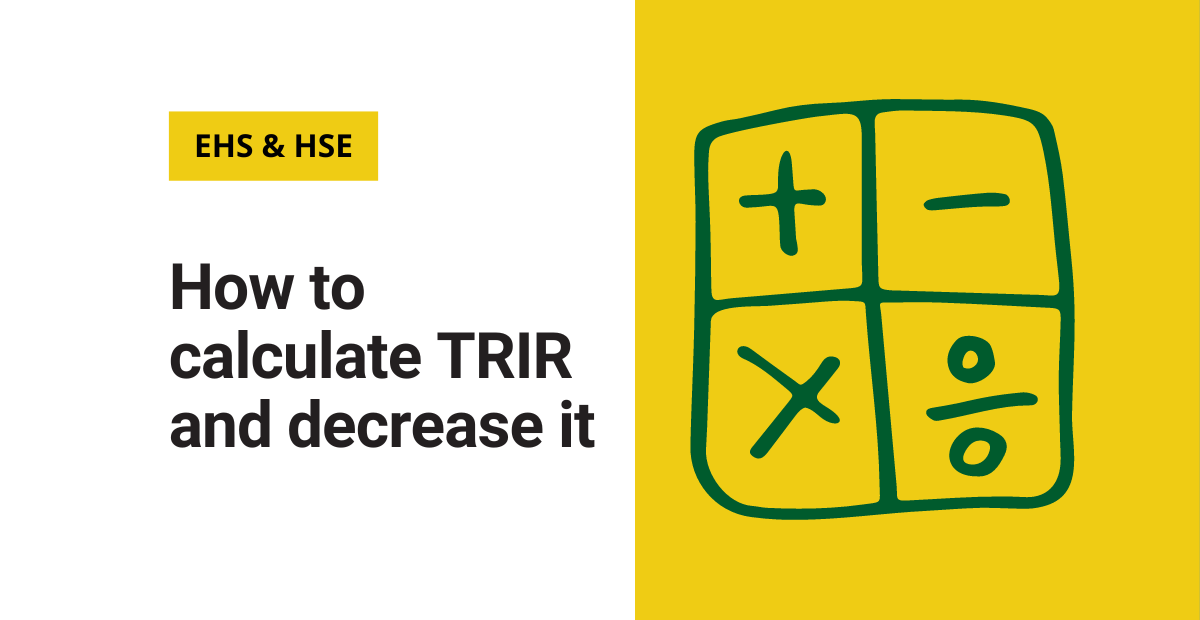The total recordable incident rate (TRIR) is a measure of the number of recordable incidents per 100 employees over a given period. It’s a commonly used metric to evaluate the safety performance of a company.
In this post, we’ll teach you how to calculate TRIR and how to interpret your results. Or, if you head to our TRIR calculator and input your data points, we can do the work for you.
Determine your TRIR
Use the following formula to calculate the TRIR for your facility:
(Total number of recordable incidents / Total number of hours worked) x 200,000
The first step in calculating TRIR is to determine the total number of recordable incidents that occurred during the reporting period. OSHA defines a recordable incident as an injury or illness that requires medical treatment beyond first aid, results in loss of consciousness, restriction of work or motion or involves a diagnosed medical condition caused by exposure to a hazardous substance.
Under OSHA’s recordkeeping requirements, you must list all recordable incidents on your company’s form 300.
Once you know the total number of recordable incidents, calculate the total number of hours worked by all employees during the reporting period. This figure should include both regular and overtime hours worked.
After you get both numbers, you can calculate the TRIR using the formula.
Interpret the result
A high TRIR may indicate that your safety program isn’t effective, that employees need better training, or that you need to implement more effective control measures.
A low TRIR, however, indicates that your safety program is effective and that you’re successfully controlling hazards and mitigating risks.
Compare your TRIR to that of companies within your industry for best results. This can give you some insight into how you’re performing relative to businesses with similar challenges. Because some industries pose more risks, it’s important to view your TRIR as it relates to your processes, equipment, etc.
Consider limitations of TRIR
While TRIR is a useful metric for evaluating safety performance, it does have some limitations. For one, it only considers recordable incidents and doesn’t include near misses or incidents that fall outside of OSHA’s recordables definition. So, if you’re not considering all the types of scenarios that take place, you might not have an extremely accurate perception of performance.
Another limitation of TRIR is that it doesn’t consider the severity the recordable incidents. Two companies may have the same TRIR, but one may have had more serious incidents than the other. This means that a company with a lower TRIR may still have a higher risk of serious incidents.
Improve your site’s TRIR over time
You have to improve your EHS program to decrease your TRIR. In my experience, these are some of the best ways to do that.
Hazard identification and risk assessment: Conduct regular hazard identification and risk assessments to identify hazards and implement control measures.
Employee training: Providing regular safety training to ensure that your workers are aware of potential hazards and know how to protect themselves.
Safety management system: Your safety management system should include the policies, procedures, and processes you’ll use to mitigate risks.
Near miss reporting: While not required, documenting near misses is a great way to get ahead of hazards and prevent them from causing full-blown incidents.
Safety culture: Teach employees that ownership of personal safety is one of the most important ways to stay safe at work.
TRIR is just one of many metrics used to evaluate safety performance. You should always use a variety of EHS metrics to understand your company’s strengths and opportunities. That way, you’ll be able to better identify patterns that help you eliminate hazards once and for all.
Other posts you might like…
No posts


